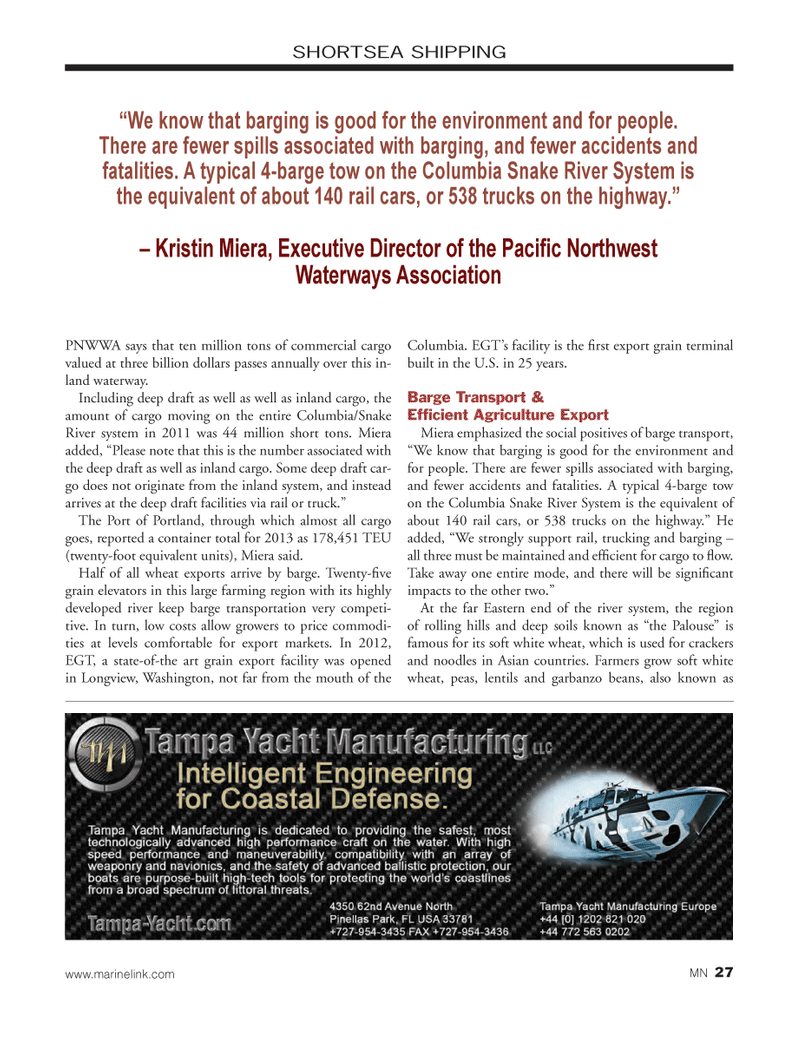
Page 27: of Marine News Magazine (March 2014)
Fleet & Vessel Optimization
Read this page in Pdf, Flash or Html5 edition of March 2014 Marine News Magazine
PNWWA says that ten million tons of commercial cargo valued at three billion dollars passes annually over this in- land waterway.
Including deep draft as well as well as inland cargo, the amount of cargo moving on the entire Columbia/Snake
River system in 2011 was 44 million short tons. Miera added, “Please note that this is the number associated with the deep draft as well as inland cargo. Some deep draft car- go does not originate from the inland system, and instead arrives at the deep draft facilities via rail or truck.”
The Port of Portland, through which almost all cargo goes, reported a container total for 2013 as 178,451 TEU (twenty-foot equivalent units), Miera said.
Half of all wheat exports arrive by barge. Twenty-fi ve grain elevators in this large farming region with its highly developed river keep barge transportation very competi- tive. In turn, low costs allow growers to price commodi- ties at levels comfortable for export markets. In 2012,
EGT, a state-of-the art grain export facility was opened in Longview, Washington, not far from the mouth of the
Columbia. EGT’s facility is the fi rst export grain terminal built in the U.S. in 25 years.
Barge Transport &
Effi cient Agriculture Export
Miera emphasized the social positives of barge transport, “We know that barging is good for the environment and for people. There are fewer spills associated with barging, and fewer accidents and fatalities. A typical 4-barge tow on the Columbia Snake River System is the equivalent of about 140 rail cars, or 538 trucks on the highway.” He added, “We strongly support rail, trucking and barging – all three must be maintained and effi cient for cargo to fl ow.
Take away one entire mode, and there will be signifi cant impacts to the other two.”
At the far Eastern end of the river system, the region of rolling hills and deep soils known as “the Palouse” is famous for its soft white wheat, which is used for crackers and noodles in Asian countries. Farmers grow soft white wheat, peas, lentils and garbanzo beans, also known as
SHORTSEA SHIPPING “We know that barging is good for the environment and for people.
There are fewer spills associated with barging, and fewer accidents and fatalities. A typical 4-barge tow on the Columbia Snake River System is the equivalent of about 140 rail cars, or 538 trucks on the highway.” – Kristin Miera, Executive Director of the Pacifi c Northwest
Waterways Association www.marinelink.com MN 27
MN MAR14 Layout 18-31.indd 27 2/21/2014 3:22:59 PM

 26
26

 28
28
